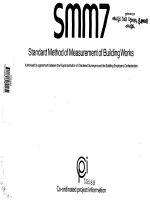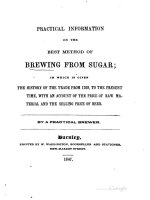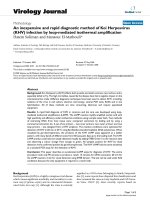ANOTHER NEW PROOF METHOD OF ANALYTIC INEQUALITY
Bạn đang xem bản rút gọn của tài liệu. Xem và tải ngay bản đầy đủ của tài liệu tại đây (265.57 KB, 10 trang )
ANOTHER NEW PROOF METHOD OF ANALYTIC INEQUALITY
XIAO-MING ZHANG, BO-YAN XI, AND YU-MING CHU
Abstract. This pap er gives another new proof method of analytic inequality involving n variables.
As its applications, we give proof of some known-well inequalities and prove five new analytic
inequalities.
1. monotonicity on special variables
Throughout the paper R denotes the set of real numbers and R
+
denotes the set of strictly
positive real numbers. Let n ≥ 2, n ∈ N. The arithmetic mean A(x) and the power mean
M
r
(x) of order r with respect to the positive real numbers x
1
, x
2
, ··· , x
n
are defined respectively
as A(x) =
1
n
n
i=1
x
i
, M
r
(x) =
1
n
n
i=1
x
r
i
1/r
for r = 0, and M
0
(x) = (
n
i=1
x
i
)
1/n
.
In paper [4], the author puts up a new proof method of analytic inequality. In this section, we
shall provide another new proof method of analytic inequality involving n variables.
Lemma 1.1. Let interval I = [m, M] ⊂ R, D
def.
=
{(x
1
, x
2
) |m ≤ x
2
≤ x
1
≤ M} ⊂ I
2
and function
f : I
2
→ R have continuous partial derivative. Then ∂f/∂x
1
≥ (≤) ∂f /∂x
2
hold in D, if and only
if f (a, b) ≥ (≤) f (a − l, b + l ) hold for all a, b ∈ I and l with b < b + l ≤ a − l < a.
Proof. Without the losing of generality, we only prove the c ase ∂f/∂x
1
≥ ∂f/∂x
2
.
For all x
1
, x
2
∈ D and l ∈ R
+
with m ≤ x
2
< x
2
+l ≤ x
1
−l < x
1
≤ M, we have f (x
1
− l, x
2
+ l)−
f (x
1
, x
2
) ≤ 0. Then it exists ξ
l
∈ (0, l) such that
l
−
∂f (x
1
− ξ
l
, x
2
+ ξ
l
)
∂x
1
+
∂f (x
1
− ξ
l
, x
2
+ ξ
l
)
∂x
2
≤ 0,
−
∂f (x
1
− ξ
l
, x
2
+ ξ
l
)
∂x
1
+
∂f (x
1
− ξ
l
, x
2
+ ξ
l
)
∂x
2
≤ 0.
Let l → 0+, we get
∂f (x
1
, x
2
)
∂x
1
≥
∂f (x
1
, x
2
)
∂x
2
.
According to continuity of partial derivative, we know
∂f (x
1
, x
1
)
∂x
1
≥
∂f (x
1
, x
1
)
∂x
2
.
hold also.
Date: September 13, 2009.
2000 Mathematics Subject Classification. Primary 26A48, 26B35, 26D20,
Key words and phrases. monotone, maximum, minimum, inequality.
This paper was typeset using A
M
S-L
A
T
E
X.
1
2 X M. ZHANG, B Y. XI, AND Y M. CHU
On the other hand, assumes ∂f/∂x
1
≥ ∂f/∂x
2
hold in D. For all a, b ∈ I and l with b < b + l ≤
a − l < a, it exists ξ
l
∈ (0, l) such that
f (a, b) −f (a −l, b + l) = −(f (a −l, b + l) − f (a, b))
= −l
−
∂f (a − ξ
l
, b + ξ
l
)
∂x
1
+
∂f (a − ξ
l
, b + ξ
l
)
∂x
2
= l
∂f (a − ξ
l
, b + ξ
l
)
∂x
1
−
∂f (a − ξ
l
, b + ξ
l
)
∂x
2
≥ 0.
we complete the proof of lemma.
Theorem 1.1. (Compressed independent variables theorem) Suppose that D ⊂ R
n
be a
symmetric with respect to permutations and convex set, and it have a nonempty interior set D
0
,
function f : D → R and its partial derivatives be continue, and
(1.1)
D
i
=
x ∈ D|x
i
= max
1≤j≤n
{x
j
}
− {x ∈ D|x
1
= x
2
= ··· = x
n
},
(1.2)
D
i
=
x ∈ D|x
i
= min
1≤j≤n
{x
j
}
− {x ∈ D|x
1
= x
2
= ··· = x
n
},
i = 1, 2, ··· , n. For all i, j = 1, 2, ··· , n, i = j,
∂f /∂x
i
> (<) ∂f/∂x
j
in
D
i
∩
D
j
. Then
(1.3) f (a
1
, a
2
, ··· , a
n
) ≥ (≤) f (A (a) , A (a) , ··· , A (a))
for all a = (a
1
, a
2
, ··· , a
n
) ∈ D, equality hold if only if a
1
= a
2
= ··· = a
n
.
Proof. If n = 2, Let l → |a
1
− a
2
|/2 in Lemma 1.1, we complete the proof of theorem. We suppose
n ≥ 3. Without the losing of generality, we only prove the case ∂f/∂x
i
> ∂f/∂x
j
with i = j.
If a
1
= a
2
= ··· = a
n
, the inequality (1.3) hold obviously. If max
1≤j≤n
{a
j
} = min
1≤j≤n
{a
j
}, we let
a
1
= max
1≤j≤n
{a
j
} and a
n
= min
1≤j≤n
{a
j
}.
(1) If a
1
> max
2≤j≤n
{a
j
}, a
n
< min
1≤j≤n−1
{a
j
}, because ∂f/∂x
i
> ∂f/∂x
j
hold in
D
1
∩
D
n
, According
to Lemma 1.1, exist a
(1)
1
, a
(1)
n
such that l = a
1
−a
(1)
1
= a
(1)
n
−a
n
> 0 and a
(1)
1
= a
i
0
= max
2≤j≤n−1
{a
j
}
(let a
(1)
1
= a
2
briefly ), or a
(1)
n
= a
j
0
= min
2≤j≤n−1
{a
j
} (let a
(1)
n
= a
n−1
briefly ), we have
f (a
1
, a
2
, a
3
, ··· , a
n
) ≥ f
a
(1)
1
, a
2
, a
3
, ··· , a
(1)
n
.
Simply, we denote a
(1)
i
= a
i
, 2 ≤ i ≤ n − 1. Consequently,
f (a
1
, a
2
, a
3
, ··· , a
n
) ≥ f
a
(1)
1
, a
(1)
2
, a
(1)
3
, ··· , a
(1)
n
.
If a
(1)
1
= a
(1)
2
= ··· = a
(1)
n
, implies Theorem 1.1 hold. Otherwise, for a
(1)
1
= a
(1)
2
> a
(1)
n
, owing to
∂f (x)
∂x
1
x=
a
(1)
1
,a
(1)
2
,a
(1)
3
,··· ,a
(1)
n
>
∂f (x)
∂x
n
x=
a
(1)
1
,a
(1)
2
,a
(1)
3
,··· ,a
(1)
n
,
ANOTHER NEW PROOF METHOD OF ANALYTIC INEQUALITY 3
and the continuity of partial derivatives, it exists ε > 0 such that
∂f (x)
∂x
1
x=
s,a
(1)
2
,a
(1)
3
,··· ,t
>
∂f (x)
∂x
n
x=
s,a
(1)
2
,a
(1)
3
,··· ,t
,
where s ∈
a
(1)
1
− ε, a
(1)
1
t ∈
a
(1)
n
, a
(1)
n
+ ε
. Denote a
(2)
1
= a
(1)
1
− ε, a
(2)
n
= a
(1)
n
+ ε, a
(2)
i
= a
(1)
i
(2 ≤
i ≤ n − 1). By Lemma 1.1, we get
(1.4) f
a
(1)
1
, a
(1)
2
, a
(1)
3
, ··· , a
(1)
n
≥ f
a
(2)
1
, a
(2)
2
, a
(2)
3
, ··· , a
(2)
n
,
and a
(2)
2
= max
1≤i≤n
a
(2)
i
. For a
(1)
1
> a
(1)
n−1
= a
(1)
n
, after a similar argument, we get inequality (1.4)
and a
(2)
n−1
= min
1≤i≤n
a
(2)
i
.
Repeated the above steps, we get
a
(i)
1
, a
(i)
2
, ··· , a
(i)
n
(i = 1, 2, ···),
n
j=1
a
(i)
j
are constant,
a
(i)
j
(i = 1, 2, ···) are monotone increasing (decreasing) sequences if a
j
≥ (≤) A (a) , j = 1, 2, 3, ··· , n,
and
f
a
(1)
1
, a
(1)
2
, a
(1)
3
, ··· , a
(1)
n
≥ f
a
(i)
1
, a
(i)
2
, a
(i)
3
, ··· , a
(i)
n
.
If exists i ∈ N, a
(i)
1
= a
(i)
2
= ··· = a
(i)
n
, we complete the proof of theorem. Otherwise, let α =
inf
i∈N
max
a
(i)
1
, a
(i)
2
, ··· , a
(i)
n
. Without the losing of generality, we suppose
max
a
(i
j
)
1
, a
(i
j
)
2
, ··· , a
(i
j
)
n
= a
(i
j
)
1
→ α
and
lim
j→+∞
a
(i
j
)
1
, a
(i
j
)
2
, ··· , a
(i
j
)
n
= (α, b
2
, b
3
, ··· , b
n
) ,
where {i
j
}
+∞
j=1
is a subsequence of N. Because of the continuity of function f , it have
f (a
1
, a
2
, a
3
, ··· , a
n
) ≥ f (α, b
2
, b
3
, ··· , b
n
) .
If α = min {b
2
, b
3
, ··· , b
n
}, we can repeat the above arguments, this contradicts with the definition
of α. Then α = b
2
= b
3
= ··· = b
n
.Owing to α +
n
i=2
b
i
=
n
i=1
a
i
, we have α = b
2
= b
3
= ··· =
b
n
= A(a), the proof of Theorem 1.1 is completed.
(2) For the case a
1
= max
2≤j≤n
{a
j
}, or a
n
= min
1≤j≤n−1
{a
j
}, it have been proved in (1).
In particular, according to Theorem 1.1 the following corollary hold.
Corollary 1.1. Suppose that D ⊂ R
n
is a symmetric with respect to permutations and convex
set, and it has a nonempty interior set D
0
, function f : D → R is symmetric, f and its partial
derivatives is continue. Let
D
1
=
x ∈ D|x
1
= max
1≤j≤n
{x
j
}
− {x ∈ D|x
1
= x
2
= ··· = x
n
},
D
2
=
x ∈ D|x
2
= min
1≤j≤n
{x
j
}
− {x ∈ D|x
1
= x
2
= ··· = x
n
},
(1.5) D
∗
=
D
1
∩
D
2
.
If ∂f/∂x
1
> (<) ∂f/∂x
2
hold in D
∗
, then
f (a
1
, a
2
, ··· , a
n
) ≥ (≤) f (A (a) , A (a) , ··· , A (xa))
for all a = (a
1
, a
2
, ··· , a
n
) ∈ D, equality hold if only if a
1
= a
2
= ··· = a
n
.
4 X M. ZHANG, B Y. XI, AND Y M. CHU
2. Unifying Proof of Some Well-known Inequality
Take advantage of Theorem 1.1 and Corollary 1.1, we can prove some well-known inequality, for
example, Power Mean Inequality, Holder-Inequality, Minkowski-Inequality. In this section, we only
prove an example.
Proposition 2.1. (Holder-Inequality) Let (x
1
, x
2
, ··· , x
n
), (y
1
, y
2
, ··· , y
n
) ∈ R
n
+
, p, q > 1, and
1/p + 1/q = 1. Then
n
k=1
x
p
k
1/p
n
k=1
y
q
k
1/q
≥
n
k=1
x
k
y
k
.
Proof. Let (a
1
, a
2
, ··· , a
n
) ∈ R
n
+
and function
f : b →
n
k=1
a
k
1/p
n
k=1
a
k
b
k
1/q
−
n
k=1
a
k
b
1/q
k
, b ∈ R
n
+
.
We have
∂f
∂b
i
= 1/q ·
n
k=1
a
k
1/p
n
k=1
a
k
b
k
1/q−1
a
i
− 1/q · a
i
b
1/q−1
i
,
∂f
∂b
i
−
∂f
∂b
j
=
1
q
n
k=1
a
k
n
k=1
b
k
a
k
1/p
(a
i
− a
j
) −
1
q
a
i
b
−1/p
i
− a
j
b
−1/p
j
.
Let b ∈
D
i
∩
D
j
(see (1.1) and (1.2)). (1)If a
i
≥ a
j
,
∂f
∂b
i
−
∂f
∂b
j
≥
1
q
n
k=1
a
k
b
i
n
k=1
a
k
1/p
(a
i
− a
j
) −
1
q
a
i
b
−1/p
i
− a
j
b
−1/p
j
=
1
q
a
j
b
−1/p
j
− b
−1/p
i
> 0.
(2)If a
i
≤ a
j
,
∂f
∂b
i
−
∂f
∂b
j
≥
1
q
n
k=1
a
k
b
j
n
k=1
a
k
1/p
(a
i
− a
j
) −
1
q
a
i
b
−1/p
i
− a
j
b
−1/p
j
=
1
q
a
i
b
−1/p
j
− b
−1/p
i
> 0.
According to 1.1, we get
f (b) ≥ f (A (b) , A (b) , ··· , A (b)) .
that is
(2.1)
n
k=1
a
k
1/p
n
k=1
a
k
b
k
1/q
−
n
k=1
a
k
b
1/q
k
≥ 0.
Let a
k
= x
p
k
, , b
k
= y
q
k
x
p
k
in (2.1), we know Holder-Inequality hold.
3. Five new inequalities
Let n ≥ 3, a = (a
1
, a
2
, ··· , a
n
) ∈ R
n
+
,
k
n
(a) =
1≤i
1
<···<i
k
≤n
1
k
k
j=1
a
i
j
1
n
k
is the third
symmetric mean of a (see [2]).
Theorem 3.1. Let 2 ≤ k ≤ n − 1, p = (k −1)/(n − 1). Then
(3.1)
k
n
(a) ≥ [A (a)]
p
[M
0
(a)]
1−p
,
p = (k −1)/(n − 1) is the best constant.
ANOTHER NEW PROOF METHOD OF ANALYTIC INEQUALITY 5
Proof. Suppose
f (a) =
n
i=1
a
i
−
(n−k)·
n
k
n(n−1)
·
1≤i
1
<···<i
k
≤n
1
k
k
j=1
a
i
j
, a = (a
1
, a
2
, ··· , a
n
) ∈ R
n
+
.
Then
∂f
∂a
1
= −
(n − k) ·
n
k
n (n − 1) a
1
n
i=1
a
i
−
(n−k)·
n
k
n(n−1)
·
1≤i
1
<···<i
k
≤n
1
k
k
j=1
a
i
j
,
∂f
∂a
1
−
∂f
∂a
2
= −
(n − k) ·
n
k
n (n − 1)
n
i=1
a
i
−
(n−k)·
n
k
n(n−1)
·
1≤i
1
<···<i
k
≤n
1
k
k
j=1
a
i
j
1
a
1
−
1
a
2
=
(n − k) ·
n
k
n (n − 1) a
1
a
2
n
i=1
a
i
−
(n−k)·
n
k
n(n−1)
·
1≤i
1
<···<i
k
≤n
1
k
k
j=1
a
i
j
(a
1
− a
2
)
−
n
i=1
a
i
−
(n−k)·
n
k
n(n−1)
·
1≤i
1
<···<i
k
≤n
1
k
k
j=1
a
i
j
·
3≤i
1
<···i
k−1
≤n
a
1
− a
2
a
1
+
k−1
j=1
a
i
j
a
2
+
k−1
j=1
a
i
j
.
(3.2)
If a ∈ D
∗
(see (1.5)),
a
1
+ (k − 1) a
2
> a
1
,
(n − k) ·
n
k
n (n − 1) a
1
a
2
>
n − 2
k − 1
ka
2
(a
1
+ (k − 1) a
2
)
,
(n − k) ·
n
k
n (n − 1) a
1
a
2
>
3≤i
1
<···i
k−1
≤n
1
(a
1
+ (k − 1) a
2
) ka
2
,
(3.3)
(n − k) ·
n
k
n (n − 1) a
1
a
2
>
3≤i
1
<···i
k−1
≤n
1
a
1
+
k−1
j=1
a
i
j
a
2
+
k−1
j=1
a
i
j
.
Combining inequality (3.2) to inequality (3.3), we have ∂f/∂a
1
−∂f/∂a
2
> 0. Owing to Corollary
1.1, we get
f (a
1
, a
2
, ··· , a
n
) ≥ (≤) f (A (a) , A (a) , ··· , A (a))
6 X M. ZHANG, B Y. XI, AND Y M. CHU
for all a = (a
1
, a
2
, ··· , a
n
) ∈ R
n
+
. It implies
n
i=1
a
i
−
(n−k)·
n
k
n(n−1)
·
1≤i
1
<···<i
k
≤n
k
−1
k
j=1
a
i
j
≥ [A (a)]
(k−1)·
n
k
n−1
.
Inequality (3.1) is proved.
Let a
1
= a
2
= ··· = a
n−1
= 1, a
n
= x in inequality (3.1), it lead to
x + k − 1
k
n − 1
k − 1
n
k
≥
x + n − 1
n
p
n
√
x
1−p
.
p ≤
k
n
ln
x+k−1
k
−
1
n
ln x
ln (x + n − 1) − ln n
n
√
x
.
Let x → +∞ in above inequality,
p ≤ lim
x→+∞
k
n
·
1
x+k−1
−
1
nx
1
x+n−1
−
1
nx
= lim
x→+∞
kx
x+k−1
− 1
nx
x+n−1
− 1
=
k − 1
n − 1
.
So p = (k − 1)/(n − 1) is the best constant.
Theorem 3.2. Suppose n ≥ 3, a = (a
1
, a
2
, ··· , a
n
) ∈ R
n
+
, β > 0 > α. If β +α > 0, let λ =
−2α
n(β−α)
.
If β + α ≤ 0, let λ =
1
n
. Then
(3.4) [M
α
(a)]
1−λ
· [M
β
(a)]
λ
≤ M
0
(a) .
Proof. Let f (x) =
1
nβ
ln (
n
i=1
x
i
) −
1−λ
α
ln
1
n
n
i=1
x
α/β
i
, x ∈ R
n
+
. Then
∂f (x)
∂x
j
=
1
nβx
j
−
1 − λ
β
x
α/β−1
j
n
i=1
x
α/β
i
, j = 1, 2,
(3.5)
∂f (x)
∂x
1
−
∂f (x)
∂x
2
=
x
2
− x
1
nβx
1
x
2
−
1 − λ
β
x
α/β−1
1
− x
α/β−1
2
n
i=1
x
α/β
i
.
Case 1 :α + β > 0. Let
g (t) =
β + α
β −α
t
β−α
− t
β
+ t
−α
−
β + α
β −α
, t ∈ (1, +∞) .
Then
t
α+1
g
(t) = (β + α) t
β
− βt
β+α
− α,
t
α+1
g
(t)
= (β + α) βt
β+α−1
t
−α
− 1
> 0.
Therefore t
α+1
g
(t) is monotone increasing function in (1, +∞). Meanwhile
lim
t→1+
t
α+1
g
(t) = lim
t→1+
(β + α) t
β
− βt
β+α
− α
= 0.
Thence, t
α+1
g
(t) > 0, g
(t) > 0. In addition to lim
t→1+
g (t) = 0, we have g (t) > 0 and
β + α
β −α
t
β−α
− t
β
+ t
−α
−
β + α
β −α
> 0
β + α
β −α
t
β
−
1 +
2α
β −α
t
α
− t
α+β
+ 1 > 0,
ANOTHER NEW PROOF METHOD OF ANALYTIC INEQUALITY 7
β + α
β −α
t
β
−
n − 1 +
2α
β −α
t
α
− t
α+β
+ (n − 1) > 0,
(3.6) (1 − nλ) t
β
− (n − 1 − nλ) t
α
− t
α+β
+ (n − 1) > 0,
(3.7) (1 − λ)
1 − t
α−β
t
α
+ (n − 1)
>
t
β
− 1
nt
β
.
We assume that x ∈ D
∗
(see (1.5)), let t = (x
1
/x
2
)
1/β
in above inequality. It has
(1 − λ)
x
α/β−1
2
− x
α/β−1
1
x
α/β
1
+ (n − 1) x
α/β
2
>
x
1
− x
2
nx
1
x
2
,
(3.8)
1 − λ
β
x
α/β−1
2
− x
α/β−1
1
n
i=1
x
α/β
i
>
x
1
− x
2
nβx
1
x
2
.
Combining inequality (3.5) to inequality (3.8), we have ∂f (x)/∂x
1
− ∂f (v)/∂x
2
> 0. According
to Corollary 1.1, we get
f (x
1
, x
2
, ··· , x
n
) ≥ f (A (x) , A (x) , ··· , A (x)) ,
1
nβ
ln
n
i=1
x
i
−
1 − λ
α
ln
1
n
n
i=1
x
α/β
i
≥
λ
β
ln
1
n
n
i=1
x
i
.
Let a
i
= x
1/β
i
, i = 1, 2, ··· , n, it get
[M
α
(a)]
1−λ
· [M
β
(a)]
λ
≤ M
0
(a) .
Case 2: α + β < 0. Let t > 1, because α < 0, α + β < 0, it has
(n − 1) > (n − 2) t
α
+ t
α+β
.
We find that inequality (3.7) hold.The rest of the pro ofs are similar, so we shall omit them.
A similar argument lead to Theorem 3.3
Theorem 3.3. Suppose n ≥ 3, a = (a
1
, a
2
, ··· , a
n
) ∈ R
n
+
, β > 0 > α. If β + α > 0, let θ =
n−1
n
.
If β + α ≤ 0, let θ = 1 −
2β
n(β−α)
. Then
(3.9) M
0
(a) ≤ [M
α
(a)]
1−θ
· [M
β
(a)]
θ
.
Remark 3.1. Inequality 3.4 3.9 improve the well-known Sierpinski-Inequality
[M
−1
(a)]
n−1
n
[A (a)]
1
n
≤ M
0
(a) ≤ [M
−1
(a)]
1
n
[A (a)]
n−1
n
.
For n ≥ 2, a = (a
1
, a
2
, ··· , a
n
) ∈ R
n
+
, paper [1] introduces an inequality
n − 1
n
A (a) +
1
n
M
−1
(a) ≥ M
0
(a)
We can improve the inequality by Theorem 3.4 and Theorem 3.5.
Theorem 3.4. Suppose p = n
2
n
2
+ 4n − 4
, then
(3.10) pA (a) + (1 − p) M
−1
(a) ≥ M
0
(a) .
8 X M. ZHANG, B Y. XI, AND Y M. CHU
Proof. Firstly, Let p > n
2
n
2
+ 4n − 4
,
f (b) = p/n ·
n
i=1
e
b
i
+ (1 − p) n ·
n
i=1
e
−b
i
−1
, b = (b
1
, b
2
, ··· , b
n
) ∈ R
n
.
Then
∂f
∂b
1
=
p
n
e
b
1
+ (1 − p)
n
(
n
i=1
e
−b
i
)
2
e
−b
1
,
∂f
∂b
1
−
∂f
∂b
2
=
p
n
e
b
1
− e
b
2
− (1 − p)
n
(
n
i=1
e
−b
i
)
2
e
−b
2
− e
−b
1
.
If b
1
= max
1≤i≤n
{b
i
} > b
2
= min
1≤i≤n
{b
i
}, t = e
b
1
−b
2
> 1. We have
∂f
∂b
1
−
∂f
∂b
2
≥
p
n
e
b
1
− e
b
2
− (1 − p)
n
((n − 1) e
−b
1
+ e
−b
2
)
2
e
−b
2
− e
−b
1
=
e
b
1
− e
b
2
n ((n − 1) e
b
2
+ e
b
1
)
2
p
(n − 1) e
b
2
+ e
b
1
2
− (1 − p) n
2
e
b
1
e
b
2
=
e
3b
2
(t − 1)
n ((n − 1) e
b
2
+ e
b
1
)
2
p (n − 1 + t)
2
− n
2
t + pn
2
t
.
>
e
3b
2
(t − 1)
n ((n − 1) e
b
2
+ e
b
1
)
2
n
2
n
2
+ 4n − 4
(n − 1 + t)
2
− n
2
t +
n
2
n
2
+ 4n − 4
n
2
t
=
ne
3b
2
(t − 1) (t − n + 1)
2
(n
2
+ 4n − 4) ((n − 1) e
b
2
+ e
b
1
)
2
≥ 0.
According to Corollary 1.1, we get
f (b) ≥ f (A (b) , A (b) , ··· , A (b)) ,
p
n
n
i=1
e
b
i
+ (1 − p)
n
n
i=1
e
−b
i
≥ e
A(b)
=
n
n
i=1
e
b
i
.
Let e
b
i
= a
i
in above inequality, we know inequality (3.10) hold. Because of continuity, if p =
n
2
n
2
+ 4n − 4
, inequality (3.10) hold also .
Theorem 3.5. Suppose p =
1 − n −
√
5n
2
− 6n + 1
2n, then
n − 1
n
A (a) +
1
n
M
p
(a) ≥ M
0
(a) .
Proof. Let
f (a) =
n
n
i=1
a
1/p
i
− (n − 1)
n
2
·
n
i=1
a
1/p
i
, a ∈ R
n
+
.
Then
∂f
∂a
1
=
1
npa
1
n
n
i=1
a
1/p
i
−
n − 1
n
2
p
a
1/p−1
1
,
∂f
∂a
1
−
∂f
∂a
2
= −
a
1
− a
2
npa
1
a
2
n
i=1
a
1/np
i
−
n − 1
n
2
p
a
1/p−1
1
− a
1/p−1
2
.
If a
1
= max
1≤i≤n
{a
i
} > a
2
= min
1≤i≤n
{a
i
} > 0, a
1
/a
2
= t > 1. Owing to p < 0,−
a
1
−a
2
npa
1
a
2
> 0, we have
∂f
∂a
1
−
∂f
∂a
2
≤ −
a
1
− a
2
npa
1
a
2
a
1/(np)
1
a
(n−1)/(np)
2
−
n − 1
n
2
p
a
1/p−1
1
− a
1/p−1
2
=
a
1/p−1
1
n
2
p
−n
t − 1
t
t
1−(n−1)/(np)
− (n − 1)
1 − t
1−1/p
.
(3.11)
ANOTHER NEW PROOF METHOD OF ANALYTIC INEQUALITY 9
Let g (t) = −nt
1−(n−1)/(np)
+ nt
−(n−1)/(np)
+ (n − 1) t
1−1/p
− (n − 1) , t > 1.
g
(t) =
−n +
n − 1
p
t
−(n−1)/(np)
−
n − 1
p
t
−1−(n−1)/(np)
+ (n − 1)
1 −
1
p
t
−1/p
,
t
1+(n−1)/(np)
g
(t) =
−n +
n − 1
p
t −
n − 1
p
+ (n − 1)
1 −
1
p
t
1−1/(np)
.
t
1+(n−1)/(np)
g
(t)
=
−n +
n − 1
p
+ (n − 1)
1 −
1
p
1 −
1
np
t
−1/(np)
>
−n +
n − 1
p
+ (n − 1)
1 −
1
p
1 −
1
np
= 0.
Thus t
1+(n−1)/(np)
g
(t) is a monotone increasing function. Meanwhile,
lim
t→1+
t
1+(n−1)/(np)
g
(t) = lim
t→1+
−n +
n − 1
p
t −
n − 1
p
+ (n − 1)
1 −
1
p
t
1−
1
np
= −1 −
n − 1
p
≥ 0.
Therefore t
1+(n−1)/(np)
g
(t) > 0, g
(t) > 0, g (t) is monotone increasing function. Meanwhile,
lim
t→1+
g (t) = 0, then g (t) > 0. By (3.11), we know ∂f/∂a
1
− ∂f/∂a
2
< 0. According to Corollary
1.1,
f (a) ≤ f (A (a) , A (a) , ··· , A (a)) ,
n
n
i=1
a
1/p
i
−
n − 1
n
2
·
n
i=1
a
1/p
i
≤
1
n
· A
1/p
(a)
Finally, let a
i
→ a
p
i
(i = 1, 2, ··· , n) in the above inequality, we know Theorem 3.5 hold.
Remark 3.2. More applications of Theorem 1.1 and Corollary 1.1 will appear in book [5] and
/>Acknowledgments This work was supported by the NSF of China Central Radio and TV
University under Grant No. GEQ1633 and Foundation of the Educational Committee of Zhejiang
Province under Grant Y200804124.
References
[1] Alzer, H., Sierpinski’s inequality, J. Belgian Math. Soc. B, 41 (1989), 139-144.
[2] J J. Wen, Hardy mean and their inequalities, J. of Math., 27, 4 (2007), 447–450(in chinese).
[3] J J. Wen, W L. Wang, The optimizations for the inequalities of power means. Joural of In-
equalities and Applications, 2006 (2006), Article ID 46782, 25 page. [ONLINE]Available online at
/>[4] X M. Zhang, A new proof method of analytic inequality. Research Report Collection, 12, 1(2009), Art. 2. [ON-
LINE] Available online at ff.vu.edu.au/RGMIA/v12n1.asp
[5] X M. Zhang, Y M. Chu, New discussion to analy tic inequality, HarBin: HarBin Institute of Technology Press,
2009. (in chinese)
[6] X M. Zhang, Optimization of Schur-Convex Functions, Mathematical Inequalities and Applications, 1, 3 (1998),
319-330. [ONLINE] Available online at />10 X M. ZHANG, B Y. XI, AND Y M. CHU
(X M. Zhang) Zhejiang Broadcast and TV University Haining College, Haining City, Zhejiang
Province, 314400, P. R. China
E-mail address:
(B Y. Xi) Department of Mathematics of Inner Mongolia University for the Nationalities, Tongliao,
Inner Mongolia, 028000, P. R. China
E-mail address:
(Y M. Chu) Department of Mathematics, Huzhou Teachers C ollege, Huzhou 313000, P.R.China
E-mail address:









